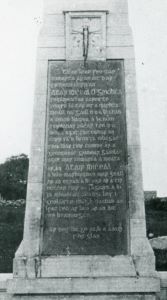THE UNVEILING OF A PLAQUE TO FR. GRIFFIN

by Tom Kenny
On November 14th, 1920, a young curate, Father Michael Griffin was lured from his house at No. 2, Montpelier Terrace by the Black and Tans. Whatever ruse they used to get him out of the house, it was not to go on a sick call, as he did not take the holy oils or the Eucharist with him, but went peacefully. He went missing and volunteers and search parties were organised and combed the city and surrounding countryside looking for him. A week later his body was found buried in a bog at Clochsgoilte in Barna. There was an international outcry. He had worked in the parish of Rahoon since June, 1918 and was hugely popular. He spoke in Irish to young and old, organised feiseanna, currach races and donkey races on Silver Strand. He was very republican and was suspected by the Tans of having heard the last confession of the informer Patrick Joyce, which was probably the reason why they abducted him and tried to extract the identity of Joyce's killers from him.
Father Griffin is still well remembered and commemorated in Galway, there is a monument to him at the location where his body was found at Cloch Sgoilte in Barna; a new road which was built shortly after his death was named Fr. Griffin Road and has a stone plaque with Gaelic lettering beautifully carved by Martin Fahy at the Salthill end of the road to commemorate that fact. Most Galwegians have probably never registered the fact that the plaque is there. A Gaelic Football Club formed in 1948 in the city was named after him. On the fiftieth anniversary of his murder in 1970, Father Griffin’s GAA club erected a plaque to his memory on the house he had lived in.
One of the most colourful ceremonies held in the city up to that point began with a mass in the cathedral celebrated by his Lordship, Bishop Michael Browne. This was followed by a parade from the cathedral to Montpelier Terrace. It was led by St. Patrick’s Boys school band and included relatives of Fr. Griffin, The Mayor Michael Smith, members of the corporation with the Sword and Mace, members of the Fr. Griffin's Club, representatives of the old I.R.A. as well as the general public. The plaque was unveiled by Pat Fanning, President of the GAA who was accompanied by the general secretary, Seán Ó Síocháin.
Our first photograph today is of a section of the crowd who attended the unveiling. Included are no less than five former mayors of the city, Mary Byrne, Paddy O’Flaherty, Gerry Colgan, Fintan Coogan senior and Paddy Ryan. Among the club members we see are Fr. Seán Foy, Mick Dolan, Jim Kilroy, Dan O’Neill, Matthew Deane and, with the banner, three All-Ireland winners, Liam Sammon, Marty Newell and Colie McDonagh. On the far right of picture is club president, Seán Turke who was very involved in the war of Independence and who stood guard over Fr. Griffin's coffin at his wake. In the foreground, in uniform is Mick Dolan, mace bearer and fireman. Also visible are Billy Riordan and Piaras Conneely.

Two men who were at the inaugural meeting of the club were also present, Paddy O’Brien from St. Bridget’s Terrace and Sonny Molloy, both of whom played football for the Monastery School team and later Fr. Griffin’s. Sonny once scored five goals in a match which prompted the headline “Five-Goal Molloy” in a local paper, a headline that those of us who worked in High Street were never allowed to forget.
The man at the bottom of the photograph was Paddy Flynn from Fairhill, well known as a seller of newspapers on the street, sometimes known as Ghisyum.
The second photograph is of the monument in Cloch Sgoilte which is also carved with beautiful Gaelic script. Every time I stand at the monument, I get the shivers thinking of what went on there.
.png)